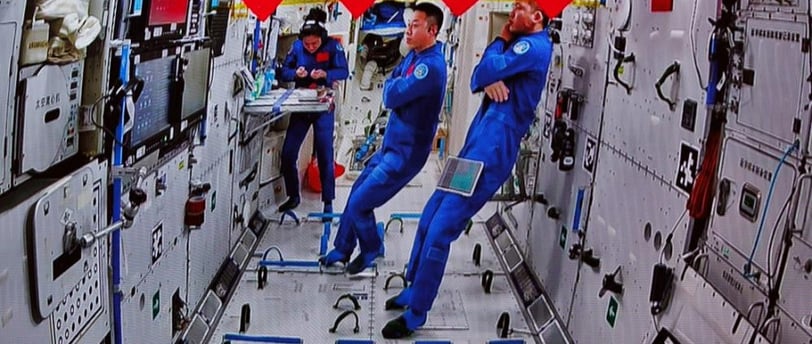Shenzhou-20 Mission: Advancements in the Tiangong Space Station
China successfully launched the Shenzhou-20 mission, sending three astronauts to the Tiangong space station. This milestone represents a significant advance in China's space program, focusing on new operations and orbital maintenance.
SCIENCE
Team Spark News
4/27/20253 min read


China Successfully Launches Shenzhou-20 Mission to Tiangong Space Station
This week, China successfully launched the Shenzhou-20 mission, sending three astronauts to the Chinese Tiangong space station. According to Chinese state media reports, the Long March 2F rocket lifted off from the Jiuquan launch base in the Gobi Desert, carrying the crewed capsule to another key stage in the country's ambitious space program.
This event strengthens China’s presence in space, solidifying Tiangong as an operational and strategic station for science and technology while enhancing China’s growing leadership in the international space arena.
Key Objectives of the Shenzhou-20 Mission
The Shenzhou-20 mission has several key objectives:
Replace the crew from the previous Shenzhou-19 mission.
Perform maintenance and upgrades on the Tiangong space station.
Conduct a series of scientific experiments in microgravity.
Test new life support and safety systems in orbit.
The crew consists of:
Commander Zhang Lu, a veteran of previous missions.
Astronaut Li Guangsu, a space science expert.
Astronaut Wang Yaping, returning to space as part of an ongoing effort to promote gender equality in China’s space program.
According to the Chinese space agency (CMSA), the astronauts will stay aboard the station for approximately six months, conducting experiments in space medicine, biotechnology, materials physics, and fundamental sciences.
The Tiangong Space Station: An Orbital Laboratory
Tiangong, which means “Celestial Palace,” was designed to operate similarly to the International Space Station (ISS) but is entirely built and operated by China.
The current station structure consists of three modules:
Tianhe (the central command and living module).
Wentian (a laboratory dedicated to bioscience).
Mengtian (a laboratory focused on physics and technology experiments).
Since its assembly, Tiangong has been used for long-duration missions, demonstrating China’s ability to maintain sustained operations in space, including spacewalks, cargo transfers, and complex scientific experiments.
With the Shenzhou-20 mission, the station enters a new cycle of operations, expanding its research capabilities and testing new technologies vital for future lunar projects and deep-space exploration.
Strategic Importance of the Mission
The success of Shenzhou-20 is more than just a scientific and technical achievement; it also has political and strategic implications. China is positioning itself as one of the few nations capable of independently conducting crewed space operations in an era of growing global tensions and competition for space dominance.
Unlike the ISS, which involves several countries under the leadership of the U.S. and Russia, Tiangong is exclusively operated by China. This gives China complete autonomy over scientific, operational, and safety decisions.
Furthermore, China has already signaled its intention to open the station for international collaborations, particularly with developing countries that currently lack a presence in space.
Technological Advancements of the Shenzhou-20 Mission
Some of the technological advancements highlighted in the Shenzhou-20 mission include:
New water and air recycling systems, increasing the station’s autonomy.
High-speed communication technology, enabling real-time transmissions to Earth.
Updates to the Tianhe module's propulsion system, ensuring better orbital stability.
The mission will also carry a load of new scientific experiments, including plant seeds to study genetic mutations in microgravity, investigations into metallic materials, and biomedical research focusing on human cell behavior in space environments.
International Reactions
The launch was closely followed by agencies and experts worldwide. Many consider Shenzhou-20 yet another demonstration of the rapid progress of China’s space program, which in recent years has achieved remarkable feats such as:
Sending probes to Mars (Tianwen-1 mission).
Landing robotic vehicles on the far side of the Moon (Chang’e 4 mission).
Building and operating its own space station.
“This is another reminder that China is continuously and ambitiously investing in space, both for scientific and strategic purposes,” said Dr. James Head, a planetary science professor at Brown University.
Future of China’s Space Program
The success of Shenzhou-20 is only part of a larger vision. China has already announced plans for:
Crewed lunar missions by 2030.
Construction of an international lunar base.
Asteroid exploration and Mars sample-return missions.
Additionally, Tiangong may receive additional modules or be expanded in the future to accommodate more experiments and international crews.
The next mission, Shenzhou-21, is already in preparation, with a scheduled launch for next year, continuing China’s human presence in space.
Conclusion
The launch of the Shenzhou-20 mission marks another historic milestone for China’s space program. By sending three astronauts to the Tiangong space station, China demonstrates its technological, scientific, and operational capacity, solidifying itself as a top-tier space power.
As astronauts work on experiments that could benefit humanity, the mission also strengthens China’s role in the emerging space geopolitical landscape, showing that the "Celestial Palace" is just beginning to shine on its journey to the stars.
Source: xinhuanet.com
Read more...
Foto de xinhuanet
News
Stay up to date with the latest technological news, Science, Internet, Social Networks and Smartphones.
© 2025. All rights reserved.
